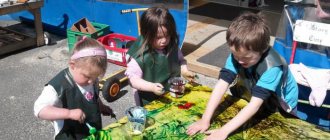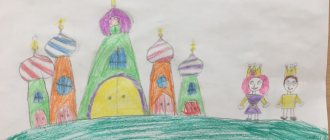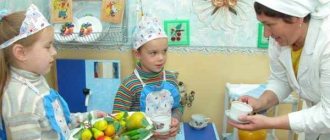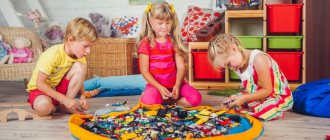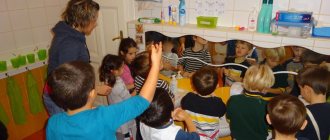Types and forms of employment in the preparatory group
Labor education runs a red line through all areas of educational activity in preschool educational institutions through the organization of different types of classes.
Orders
In this type of activity, two motives for work are realized at once: the desire to be useful and praise. Older preschoolers receive instructions from authoritative adults with great enthusiasm. And for the sake of praise, the desire to be useful, they do everything to complete the assignment well and as quickly as possible. For example, they remove toys from the playground after a walk.
Orders can be of three types:
- individual (the student receives the task of watering the ficus in a group),
- group (instructions are addressed to 2–4 children, for example, after a leisure activity, put the gaming material into boxes - dolls, cars, board games, sports equipment),
- general (all children in the group receive the task, for example, put away their writing utensils in a box, laying out pencils separately, pens separately, after the literacy lesson is over).
In the educational process, all types of tasks are combined, which is displayed when compiling a file of work assignments. This type of work activity is especially in dire need of encouragement. And not only for the worthy execution of the assignment, but also for the initiative and desire to provide assistance.
This is interesting. The assignment does not at all exclude the assistance of an adult in completing the task. Moreover, this approach creates in children a feeling of a strong shoulder and confidence in the help of others.
When running errands, it is important for a child to know that it will be beneficial, and the child will be praised
Duty
This type of work activity involves several (2–4) children receiving a specific task, the implementation of which requires a high degree of responsibility. Duties can be of the following types:
- around the dining room, which involves laying out cutlery, placing plates of bread on tables, etc.,
- around the territory, when the children, after a walk, cover the sandbox, collect the remaining toys, sweep the paths,
- in preparation for classes, that is, the guys prepare sets of materials for each student in accordance with the educational direction of a particular lesson (paints, brushes, water, a rag, sheets of paper - for drawing with paints, etc.),
- in a corner of nature - children water flowers, pour food for fish, etc. (one of the methods of working in this type of work activity is “talking with animals, flowers,” when students thank the plants for flowering, wish them a good day, etc., which helps children understand the importance of attention and kind words for all living things).
Duties help unite a team of kids, teach them to take responsibility for their actions in front of the group, and also help them get to know each other better.
Joint work
This type of work activity is designed to develop in children the ability to coordinate their actions with the actions of their comrades, establishing a uniform pace of work. The product of joint activity is a common benefit: a cleaned area on the street, a group room decorated for the New Year. The essence of the lesson is that the teacher formulates a common task for the group, and then distributes responsibilities for its implementation. At the end, the results of this work are summarized.
In the course of joint work, preschoolers learn to negotiate and take into account the opinions of their comrades
From my own experience, I can say that I practice joint activities, for example, when preparing a group room for an open lesson. So, one child collects the toys necessary for the lesson, checking the set with the list that I gave him, the second lays out files with sets of materials on the tables, the third brings pencils to each table, the fourth wipes the dust on the shelves, etc. After At the end of the preparatory stage, I thank all the guys for their help and draw their attention to the fact that it will be convenient and pleasant for us to work in a clean and well-organized room.
This is interesting. Joint work presupposes children's dependence on each other and close contact. Therefore, it is important to select tasks so that students can fully complete their task. For example, Polina should not be assigned to work with Masha - she is distracted, and Misha should not be given the task of disassembling the construction set after the game, since the boy does not know how to work quickly, and besides, the toy will probably captivate him.
Video: example of organizing joint work activities in a preparatory group
Forms of work activity of older preschoolers
Work in the preparatory group is organized in the form:
- direct educational activities (in the classroom),
- leisure activities (walks, matinees, etc.),
- independent activities (usually in the form of instructions, for example, to remove the surroundings - dolls, a chair, toy dishes, etc. - after the game “Mothers and Daughters”).
In good weather, work activities are organized mainly outdoors
Conducting a lesson on labor activity in a preparatory group
In the preparatory group, the lesson lasts 30 minutes. Lessons in the educational direction “Labor Education” consist of three stages:
- introductory part (children get ready to complete the task using motivational techniques) - up to 5 minutes,
- the main part (actually completing the task, as well as physical education pause) - up to 20 minutes,
- conclusion (evaluation of work by the teacher and children) - up to 5 minutes.
The main part of the lesson is aimed at directly mastering work skills for children
Video: introductory stage of an appliqué lesson on the theme “Spring” in a preparatory group
Table: summary of a lesson on work activity “Professions of our kindergarten” (fragment)
| Author | Degtyareva I.V., teacher of kindergarten No. 30, Rybinsk, Yaroslavl region. |
| Introductory stage | Children enter the group and sit on chairs in a semicircle. V.: Today I went to kindergarten and noticed that everyone was in a hurry. Where do you think people rush in the morning? (Children's answers). Where do most people go? (To work). Why do people go to work? (Children's answers). Guys, tell me, where and what do your parents work for? (Children's answers). Well done, you already know well where and what your parents work for. Guys, how can you call a seller, a cook, an administrator, and a carpenter in one word? What it is? (Profession). Guys, there are a lot of different professions, and people of different professions also work in our kindergarten. Listen to my riddles and guess what profession we are talking about:
|
| Main part | <,… V.: Guys, now let’s play the game “Who needs this item?” (On the table there is a ladle, a whistle, notes, a phonendoscope, an iron, a toy rake, brushes and a sheet of paper, a toy mop, a pointer, a hammer) ...>, <,... V.: I suggest you become designers today. Who are the designers? So today we will make and decorate gifts for our teachers and employees. Choose which teacher you would like to give a gift to and take your seats. Guys, look, on your tables there are photographs of the employees to whom you will give gifts. What kind of gift do you think we can give with a photograph? (Photo frame). Let's remember how to make flowers from napkins...>, |
| The final stage | Q: Guys, did you like the crafts made from napkins? What did you like most about the lesson? Was there anything new for you? Tell me, what difficulties did you encounter? (Children's answers). We will keep our gifts and present them at the graduation ceremony. Thanks to all! |
| Quote from: https://pedrazvitie.ru/raboty_doshkolnoe_new/index?n=38717 | |
Table: lesson notes on manual labor (doing crafts) “Fish in an aquarium” (fragment)
| Author | Lebedeva S.A., teacher of MBDOU D/s No. 93 of compensatory type, Nizhny Novgorod. |
| Introductory stage | Children stand near the teacher. Music sounds (sound of water). The teacher asks riddles:
<,… Q.: Who are these riddles about? (About fishes). How are fish divided according to their place of residence? (In water: in the sea - sea, in a river - river, in a lake - lacustrine, in an aquarium - aquarium). The guys from a neighboring kindergarten sent us an aquarium as a gift, and only one fish swims in it. Let's look at it (fins, scales, tail). I suggest you make friends for her so that she doesn't get bored. Take a seat…>, |
| Main part | The children sit at the tables. Opposite each child is a set of materials needed to make fish. V.: We will all work together, collectively. We will do this work from paper, cardboard and natural materials. In front of you are 2 pieces of fish: one is white, and the other is processed with plasticine. Let's start working with the white blank. Let's start making the fish from the upper fin. Take a red rectangle and fold it like an accordion. Using scissors, we cut it obliquely, unfold it, glue it to the fish...>, <,... Physical education...>, <,... V.: We take the second piece, treated with plasticine, and glue it to the bottom one. Glue a decorative eye onto the plasticine. Now let's decorate the fish. We attach pistachio shells or watermelon seeds to the plasticine base, whatever you like. |
| The final stage | V.: Look what beautiful fish you got! Well done. Now let's put our fish in the aquarium. Look how many friends our fish now has! Which fish did you like best? Why? |
| Quote from: https://nsportal.ru/detskiy-sad/konstruirovanie-ruchnoy-trud/2015/08/23/konspekt-nod-po-prikladnomu-tvorchestvu-rybki-v | |
Video: lesson on labor activity “Culinary Academy” in the preparatory group
Labor education in kindergarten is implemented through the systematic introduction to work with children of different types of labor activities. In the preparatory group, children generalize the knowledge, skills and abilities acquired earlier, and also show greater independence not only creatively, but also organizationally (in choosing materials, preparing the necessary materials for creativity) when doing manual labor. All this requires the teacher to competently use methodological techniques to motivate and organize the activities of preschoolers.
